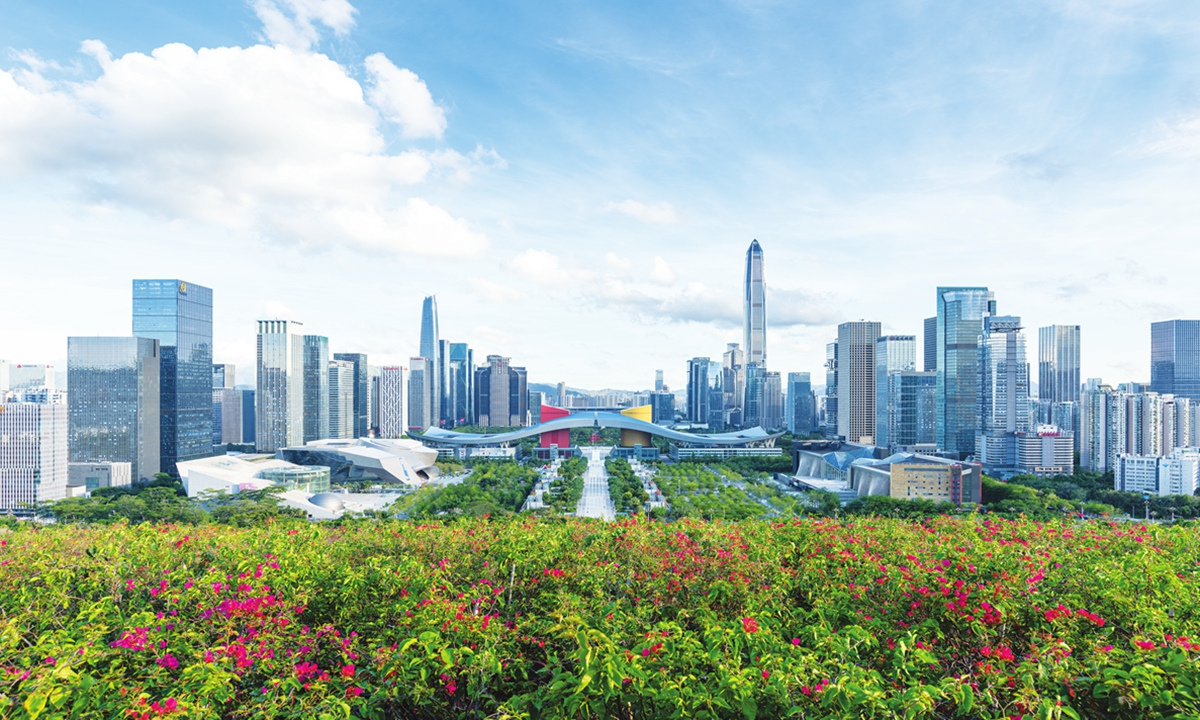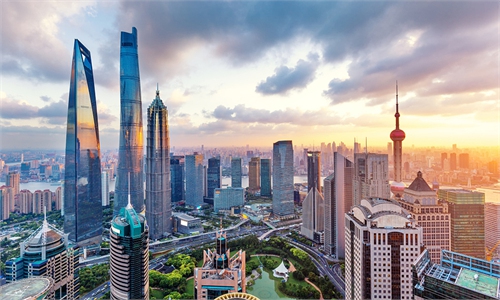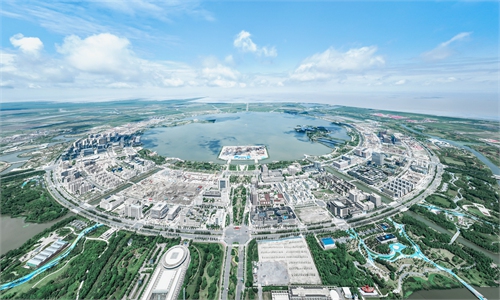
A view of Shenzhen, South China's Guangdong Province Photo: VCG
Editor's Note:This year marks the 45th anniversary since China introduced the policy of reform and opening-up. During this period, China has seen rapid development in multiple spheres, ranging from high-quality economic growth, to impressive technology development to robust people-to-people exchanges. To sum up the key to China's success while looking into the prospects of its development, we have selected opinion pieces from several scholars, explaining why reform and opening-up is the path China must take.
This is the first piece of the series.
From December 18 to 22, 1978, the Third Plenary Session of the 11th Central Committee of the Communist Party of China (CPC) was held in Beijing, which proposed the task of reform and opening-up, "a crucial move in making China what it is today." This policy has created the miracle of China's rapid economic growth and long-term stable social development. This year marks the 45th anniversary of reform and opening-up. Today, many people are still searching for an answer to the question: What is the secret of China's great achievements in its 45 years of reform and opening-up?
Consistent adherence to reform and opening-up as an 'important key'
Reform and opening-up created the miracle of China's rapid economic growth. First, China has always adhered to this key. Chinese President Xi Jinping once described the reform and opening-up as "a great reawakening" of the CPC.
Through multiple CPC meetings, China has been exploring the direction and path of the country's reform and opening-up. The spirit of these important Party meetings has become the basis and strategic guidance for guiding the country's annual development, five-year plans and medium- and long-term developments. It is also a gradual and dynamic adjustment process to search for universal laws, forge a broad consensus, and move "from practice to theory back to practice."
Second, we have adhered to freeing our minds, seeking truth from facts, moving with the times, and applying a realistic and pragmatic approach and being guided by Marxism. The discussion that practice is the sole criterion for testing truth formed a nationwide movement for the emancipation of thought, having a significant and far-reaching impact on the development of reform and opening-up. Vigor and creativity are one of the distinctive features of China's development.
Third, we have always taken economic development as the central task and kept liberating and developing social productive forces. Development is the foundation and key to solving all problems. Exploring the relationship between the government and the market is an eternal theme. Judging from the comparison of development models in various places, using market mechanisms to solve the contradictions of insufficient development to improve per capita income and economic efficiency, and using the role of government to solve the contradictions of unbalanced development to narrow the gap and achieve fairness has become an important lesson of development.
Fourth, we have always adhered to the beliefs that "openness brings progress, while isolation leads to backwardness" and "China cannot develop in isolation from the rest of the world, and the world needs China for global prosperity." In July and August 1978, Taiping Handbag Factory and Dajin Textiles were established in Dongguan and Shunde, Foshan of Guangdong Province respectively. Its significance lies in that it is an export-oriented economic development model that actively participates in the international market economic cycle and is embedded in the international labor division system. After the global financial crisis broke out in 2008, both Foshan and Dongguan began to explore new models of global manufacturing. The two cities began to implement the "going global" strategy and entered the US and Europe's reshoring, nearshoring, and friendshoring manufacturing areas.
Fifth, we have always adhered to the concept of "this country is its people; the people are the country." In 1978, China's Engel coefficient was about 60 percent, which means that about 60 percent of residents' consumption expenditure was spent on food. At that time, the focus of people's consumption was to solve their basic needs, for example, food and clothes. In 2019, China's Engel coefficient was 28.2 percent, and the focus of people's consumption shifted to the service industry and high-quality demands such as culture, entertainment, tourism, and leisure. After eliminating absolute poverty, meeting "the people's ever-growing needs for a better life" has become the starting point and foothold of governance of the CPC.
New opportunities and challenges for deepening reform and opening-up
First, in achieving common prosperity for all people, we will face new opportunities and challenges. The issue of unbalanced development has accelerated the formation of mechanisms for the flows of production factors and coopetition among society, regions, urban and rural areas, and sectors. It effectively liberates and develops socially productive forces. However, it also inevitably brings about the contradictions of imbalanced, uncoordinated, and unsustainable development.
The second area is the export-oriented economy. In the early stages of reform and opening-up, we successfully developed a market economy, industrial economy, and export-oriented economy through export orientation and investment attraction. However, this path has also led to the break-in period and friction between the Chinese and the world economy. It is a basic fact that China's GDP growth rate has been consistently higher than its foreign trade growth rate in the long term, while further stabilizing the import and export. This proves once again that expanding domestic demand is the cornerstone of the modernization of a big country.
Third, being a technological powerhouse is both an opportunity and a challenge. Participating in the international circulation and embedding in the international division of labor system without independent intellectual property rights, independent brands, and marketing channels will inevitably lead to relatively weak technological self-reliance. In the situation of technological competition between China and the US, it is both a challenge and an opportunity to not only deal with the pressure of Western technological blockade and product dumping, but also explore the path of seeking technological self-reliance while engaging in international cooperation.
Fourth, we also face the problem of how to achieve harmonious coexistence between humans and nature in modernization. Rapid industrialization will bring about the contradiction of harmonious coexistence between humans and nature. This not only requires the development of green technology but also the creation of green employment and GDP. It also requires the development of green finance, trade, and investment. This requires accelerating the transformation to green development and high-quality development.
Fifth, changes in the international environment bring new opportunities and challenges. Globalization has stagnated, global trade and investment have slowed down, and global supply chains have seen blockades. The geopoliticalization of economic and trade issues has brought about new contradictions and problems between development and security, openness and autonomy, and reform and politics.
How to go further and more steadily down the road of reform and opening-up
First, continuously improving relative productivity growth is the key. Currently, internationally there are various pessimistic views about China's economy. I found during my research that it is of the utmost importance that we do our own thing well, especially to improve relative total factor productivity. This requires solidly promoting new urbanization and expanding high-standard opening-up to continuously improve relative productivity growth.
Second, we need to implement the new development concept to establish a new development pattern. This requires a new ideological emancipation movement so that the idea that "development is the first priority, talent serves as the first resource, and innovation is the first driving force" becomes the consensus and common action of the whole society.
At the same time, one of the foundations of modernization for a major country lies in expanding domestic demand and driving import demand growth. The bottoming out and elimination of bottlenecks in the domestic circulation are not only related to high-quality development but also involve the common well-being of people around the world. The "dual circulation" should mutually promote and cultivate new advantages in international cooperation and competition, which is an important pivot for a major country's modernization, and will stimulate positive interaction between the Chinese and the world economy.
Third, we need to deepen supply-side structural reform and coordinate it with the expansion of domestic demand. Deepen supply-side structural reform emphasizes that the ultimate goal is to meet demand, and the fundamental approach is deepening reform. Expansion of domestic demand creates high-quality and large-scale demand guidance from the demand side, promoting the effective improvement of economic quality and reasonable growth in quantity. Similarly, stabilizing developed markets, forming high-quality Belt and Road cooperation, and cultivating new advantages in international cooperation and competition are of great significance.
Fourth, we need to promote digital and green transformation to build a modern industrial system. Xi's article on building a stronger digital economy in 2022 has provided strategic guidance for China's digital transformation. Meanwhile, China's green transformation, overcoming challenges such as green barriers and friction, is deeply promoting the construction of ecological civilization and green and low-carbon development under new circumstances.
The author is chief researcher of the China Center for International Economic Exchanges. opinion@globaltimes.com.cn



